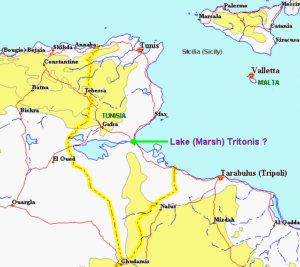Lake Tritonis *
Lake Tritonis is frequently referred to by the classical writers. Ian Wilson refers to Scylax of Caryanda as having “specifically described Lake Tritonis extending in his time over an area of 2,300 km2.“ He also cites Herodotus as confirming it as still partly extant in his time, a century later, describing it as a ‘great lagoon’, with a ‘large river’ (the Triton) flowing into it.[185.185]
Lake Tritonis was considered the birthplace of Athene, the Greek Goddess of Wisdom, after whom Athens is named. The exact location of the lake is disputed but there is some consensus that the salty marshes or chotts of central Tunisia and North-East Algeria are the most likely candidates. It appears that these marshes originally formed a large inland sea connected to the Mediterranean but due to seismic activity in the area were cut off from the sea. Diodorus Siculus records this event in his third book.
I should also mention that Lake Tritonis along with the Greek island of Lemnos and the river Thermodon in northern Turkey, now known as Terme Çay, have all been associated with the Amazons(d).
Edward Herbert Bunbury, a former British MP, included a chapter(a) on Lake Tritonis in his 1879 book on the history of ancient geography [1531.v1.316]+.
geography [1531.v1.316]+.
In 1883, Edward Dumergue published[659]+ a brief study of the Tunisian chotts, which he concluded were the remnants of an ancient inland sea that had been connected to the Mediterranean Sea at the Gulf of Gabes.
Lucile Taylor Hansen in The Ancient Atlantic[572], has included a speculative map taken from Reader’s Digest showing Lake Tritonis, around 11.000 BC, as a megalake covering much of today’s Sahara, with the Ahaggar Mountains turned into an island. Atlantis is shown to the west in the Atlantic.
In 1967 Egerton Sykes published a paper entitled The Sahara Inland Sea in which he describes a vast inland sea of ‘remarkable proportions’ and “is attested not only by classical references but also by the fact that beneath most of it lies a layer of brackish water ranging from 200 to 500 feet below the ground. The various oases are believed to be located on patches where the depth is only about 50 feet, conducive to plant survival. The climatic change seems to have happened quite recently, around 5000 BC. B.C., since the classics contain numerous references to its [the inland sea] existence.”(e)
I should mention here that the Atlantis theory of George Sarantitis is entirely dependent on extensive inland waterways including the chotts of Tunisia and Algeria as well as a number of other large lakes and rivers in what is now the Sahara.
In modern times, Alberto Arecchi has taken the idea further[079] and suggested that the inland sea, where the chotts are now, was the original ‘Atlantic Sea’ and that the city of Atlantis was situated on an extended landmass to the east of Tunisia and connected to Sicily due to a lower sea level. Arecchi’s identification of the chotts with Lake Tritonis has now been adopted by Lu Paradise in a May 2015 blog(c). The Qattara Depression of Northern Egypt also contains a series of salt lakes and marshes and is believed by others to have been Lake Tritonis.
Cindy Clendenon is the author of a book [801.397] on hydromythology in which she concludes that “the now-extinct Lake Tritonis once was a Cyrenaican lagoon-sabkha complex near today’s Sabkha Ghuzayyil and Marsa Brega, Libya”(b), not in Tunisia! Clyde Winters also placed Lake Tritonis in Libya(f).
[659]+ https://archive.org/details/chottstunisorgr01dumegoog
[1531.v1.316]+ https://archive.org/stream/historyofancient01bunb#page/n6/mode/1up/search/Tritonis Vol.1
(a) Lake Tritonis – Jason and the Argonauts (archive.org) *
(b) https://www.abebooks.com/9780981842103/Hydromythology-Ancient-Greek-World-Earth-0981842100/plp
(d) https://www.myrine.at/Amazons/mobilIndex.html
(e) The Saharan Inland Sea – Atlantisforschung.de (atlantisforschung-de.translate.goog)
(f) https://africanbloodsiblings.wordpress.com/2013/11/21/fertile-african-crescent-by-clyde-winters/
